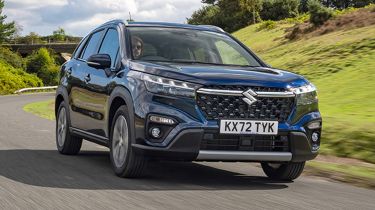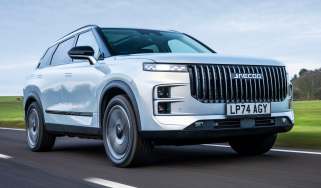Suzuki S-Cross SUV review
"The Suzuki S-Cross is good value in entry-level spec, but higher-level examples are less compelling"
Pros
- Economical
- Good-value base model
- Standard safety equipment
Cons
- Archaic automated manual transmission
- Ultra spec is only 4WD
- Gutless powertrains
With the Suzuki Vitara selling well, you’d be forgiven for forgetting all about the existence of the slightly bigger Suzuki SX4 S-Cross. The previous model, sold from 2014-2021, is a fairly rare sight on UK roads, thanks to its anonymous styling, low profile and rather average driving experience.
This is the new model and it at least features slightly braver styling. The front end brings a bold grille with chrome inserts and angled LED headlights, while the rear end has a black bar joining the tail-lights that is reminiscent of the Peugeot 2008. The chunky wheel arches and plastic cladding give it a rugged look.
 Top 10 best 4x4s and off-roaders 2025
Top 10 best 4x4s and off-roaders 2025
But unlike many crossovers, the S-Cross can go off-road. Ultra trim comes with Suzuki’s AllGrip four-wheel-drive system, with modes for driving on snow and slippery surfaces and even a low-speed one for getting out of muddy or sandy areas.
Ultra is the higher of two trim levels. The entry-level trim is called Motion and it’s very well equipped. Standard features include heated front seats, a reversing camera, front and rear parking sensors, keyless entry and start, two-zone air conditioning and a seven-inch touchscreen with Apple CarPlay and Android Auto. Ultra adds a 360-degree camera, leather seats, a bigger screen with sat nav and a panoramic sunroof but it’s expensive because it’s only available with four-wheel drive.
Both versions are available with a 1.4-litre mild-hybrid petrol engine, which Suzuki calls Boosterjet – that sounds much more exciting than it is. Boosterjet S-Cross models produce 127bhp and get from 0-62mph in around 10 seconds, which should be adequate for most buyers. The mild-hybrid assistance helps fuel economy, as the S-Cross can achieve up to 52mpg, which is easily more than you’ll get in a mild-hybrid Nissan Qashqai or Hyundai Tucson. Four-wheel-drive buyers won’t need to budget much more for fuel, as the AllGrip system only reduces fuel economy by 3-5mpg.
For 2022, Suzuki also introduced another powertrain into the range: the 1.5-litre petrol self-charging hybrid. This produces 113bhp and comes as standard with an automated manual gearbox and four-wheel drive. While it’s claimed to return a combined 54mpg on the combined WLTP cycle, this is only slightly more than the base mild-hybrid model and the self-charging hybrid’s automated manual gearbox is a pain to use.
The S-Cross may be targeting cars like the Nissan Qashqai, SEAT Ateca and Hyundai Tucson but it’s not as practical as those cars. A 430-litre boot is more in keeping with the most spacious SUVs from the class below, like the Honda HR-V and Peugeot 2008.
The S-Cross isn’t all that much bigger than the Vitara, which is noticeably cheaper and has the same engine. When the Vitara is available with four-wheel drive for significantly less than the S-Cross, we do wonder if this new model will be any more successful than the version before it.
Which Is Best?
Cheapest
- Name1.4 Boosterjet 48V Hybrid Motion 5dr
- Gearbox typeManual
- RRP£27,819
Most Economical
- Name1.5 Hybrid Motion 5dr AGS
- Gearbox typeSemi-auto
- RRP£29,569
Fastest
- Name1.4 Boosterjet 48V Hybrid Motion 5dr
- Gearbox typeManual
- RRP£27,819


















